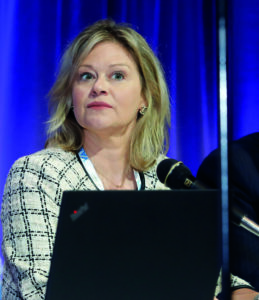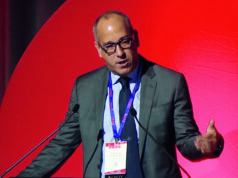
Selected research to be presented during the Wednesday afternoon, June 19, series of Vascular and Endovascular Surgery Society (VESS) Scientific Sessions (from 1:30 p.m. onward in the West Building, Level 1) will highlight areas of unmet need and offer paradigm-shifting analyses concerning thrombectomy for pulmonary embolism (PE), carotid endarterectomy (CEA) and endovascular aneurysm repair (EVAR), among other key domains.
Presenting in this afternoon’s first session, Jin Hyun Joh, MD, from University Hospital at Gangdong in Seoul, South Korea, will deliver a comparison of outcomes between percutaneous atherectomy versus balloon angioplasty and/or stenting in the treatment of femoropopliteal disease based on the Korean Society for Vascular Surgery’s (KSVS) DAMOEUM registry. The nationwide prospective multicenter repository assessed primary patency rate and postprocedural ankle-brachial index (ABI).
“There have been many studies that have reported on interventional treatments of peripheral arterial disease [PAD]; however, most of these are single-arm or company-sponsored studies, and so are not reflective of real-world practice,” Hyun Joh tells VS@VAM. Theirs, he states, will offer “meaningful real-world data,” suggestive of lower rates of occlusion recurrence post-atherectomy, but places emphasis on “careful” patient selection.
Later in this session, resident Tiffany R. Bellomo, MD, from Massachusetts General Hospital in Boston, is set to present multi-institutional retrospective registry data on the clinical and anatomic characteristics of popliteal artery aneurysms (PAAs) associated with limb-threatening and thromboembolic events. As senior author Anahita Dua, MD, also from Massachusetts General Hospital states, this research identifies a “new variable”—thrombus burden—to more accurately identify which patients will have complications, so lesions can be treated before causing an acute event.
“Through this research, we have identified thrombus burden has the biggest impact in terms of predictive value and we have quantified this through ultrasound,” Dua states. “We hope our research will allow for a new paradigm by which popliteal aneurysms can be evaluated to identify threatened patients and save limbs.”
In the following session, among several abstract presentations, resident Paul Rothenberg, MD, from West Virginia University in Morgantown, West Virginia, will deliver data on abdominal aortic aneurysm (AAA) care, discussing the impact of rural residence on the presentation of AAA and the likelihood of being lost to follow-up after endovascular repair.
Speaking to VS@VAM, Rothenberg emphasizes how deadly AAA ruptures are and how preventable they can be with appropriate screening: “Rural populations are often medically underserved and are particularly vulnerable as a result. At our institution, which is located in a highly rural state in Appalachia, our endovascular repair rate for symptomatic and ruptured AAA is nearly double the national rate reported by the VQI [29.2% vs. 15% for symptomatic AAA; 11% vs. 6.1% for ruptured AAA]. Not only are rural patients presenting with ruptured or symptomatic aneurysms, we also found these patients are lost to follow-up. We know that losing EVAR and TEVAR patients to follow-up brings worse outcomes over time, so we want to highlight these results to emphasize that these patients are not being seen over time, which represents a problem that affects rural patients more. That is why we undertook this research.”
In presenting these data, which highlight the need for access to AAA screening and surveillance in rural areas, Rothenberg and his team of researchers hope to increase resources for rural provider education, ultimately to decrease the number of patients that present with a symptomatic or ruptured AAA.
Rounding off this session with a report on long-term outcomes and adaptive changes in collateral visceral circulation following intentional celiac artery embolization (CAE) during complex EVAR/TEVAR, resident Arash Fereydooni, MD, from Stanford University in Stanford, California, outlines how this research has shown that CAE is a “useful adjunct” to extend proximal or distal seal during EVAR/TEVAR; however, mesenteric complications occur in 10–15% of patients over a 90-day postoperative period. He notes that, although CAE may have “less utility to treat complex aortic pathology in the future,” it will nevertheless “remain a technique in the toolbox of the vascular surgeon in emergency circumstances or when new-generation endografts are not readily available.”
Continuing discussion of CAE, medical student Leana Dogbe, from Penn State Hershey College of Medicine in Hershey, Pennsylvania, will later deliver data on African American women’s more frequent presentation with more severe forms of carotid disease, and the effect of their “inadequate care” on clinical outcomes. She tells VS@VAM that representation of this patient population is “lacking” in landmark trials to date, and with the U.S. population’s increasing diversity, these insights must spark “action” to mitigate poor post-surgical outcomes.
Later today, there will feature an analysis of factors which influence general surgery residents to specialize in vascular surgery. Presenting author, resident Christina Cui, MD, from Duke University in Durham, North Carolina, comments that, in the context of the projected shortage of vascular surgeons, their research highlights how “boosting pipelines is crucial to avoid impacts on patient care.”










